Effects of Tb-Doped BiVO4 on Degradation of Methylene Blue
Abstract
1. Introduction
2. Materials and Methods
2.1. Reagents and Materials
2.2. Characterization Methods
2.3. Preparation of Photocatalysts
2.4. Photocatalysis Analysis
3. Results and Discussions
3.1. Structural Characterization
3.2. Surface Morphology
3.3. Ultraviolet (UV)−Visible Absorption Spectra and Photocatalysis Analysis
3.4. Degradation Efficiency
3.4.1. The Effect of Photocatalyst Addition on the Degradation of Methylene Blue
3.4.2. Effect of the Initial Concentration of Methylene Blue on Photocatalytic Degradation Efficiency
3.4.3. Effects of Metal Ions and Inorganic Salts on the Degradation Efficiency of Methylene Blue
3.4.4. Effect of Solution pH on Photocatalytic Degradation of Methylene Blue
4. Conclusions
Author Contributions
Funding
Institutional Review Board Statement
Informed Consent Statement
Data Availability Statement
Acknowledgments
Conflicts of Interest
References
- Benny, C.K.; Chakraborty, S. Dyeing wastewater treatment in horizontal-vertical constructed wetland using organic waste media. J. Environ. Manag. 2023, 331, 117213. [Google Scholar] [CrossRef]
- Nabih, M.H.; El Hajam, M.; Boulika, H.; Chiki, Z.; Tahar, S.B.; Kandri, N.I.; Zerouale, A. Preparation and characterization of activated carbons from cardoon “Cynara Cardunculus” waste: Application to the adsorption of synthetic organic dyes. Mater. Today Proc. 2022, 72, 3369–3379. [Google Scholar] [CrossRef]
- Zhu, X.; Zhang, J.; Chen, F. Study on visible light photocatalytic activity and mechanism of spherical Bi12TiO20 nanoparticles prepared by low-power hydrothermal method. Appl. Catal. B Environ. 2011, 102, 316–322. [Google Scholar] [CrossRef]
- Hoang, S.; Guo, S.; Hahn, N.T.; Bard, A.J.; Mullins, C.B. Visible light driven photoelectrochemical water oxidation on nitrogen-modified TiO2 nanowires. Nano Lett. 2012, 12, 26–32. [Google Scholar] [CrossRef] [PubMed]
- Fujishima, A.; Honda, K. Electrochemical photolysis of water at a semiconductor electrode. Nature 1972, 238, 37–38. [Google Scholar] [CrossRef] [PubMed]
- Lasek, J.; Yu, Y.H.; Wu, J.C. Removal of NOx by photocatalytic processes. J. Photochem. Photobiol. C Photochem. Rev. 2013, 14, 29–52. [Google Scholar] [CrossRef]
- Ran, J.; Jaroniec, M.; Qiao, S.Z. Cocatalysts in semiconductor-based photocatalytic CO2 reduction: Achievements, challenges, and opportunities. Adv. Mater. 2018, 30, 1704649. [Google Scholar] [CrossRef] [PubMed]
- Nandhini, N.T.; Rajeshkumar, S.; Mythili, S. The possible mechanism of eco-friendly synthesized nanoparticles on hazardous dyes degradation. Biocatal. Agric. Biotechnol. 2019, 19, 101138. [Google Scholar] [CrossRef]
- Liu, G.Y.; Li, K.K.; Jia, J.I.A.; Zhang, Y.T. Coal-based graphene as a promoter of TiO2 catalytic activity for the photocatalytic degradation of organic dyes. New Carbon Mater. 2022, 37, 1172–1180. [Google Scholar] [CrossRef]
- Voisin, H.; Falourd, X.; Rivard, C.; Capron, I. Versatile nanocellulose-anatase TiO2 hybrid nanoparticles in Pickering emulsions for the photocatalytic degradation of organic and aqueous dyes. JCIS Open 2021, 3, 100014. [Google Scholar] [CrossRef]
- Madima, N.; Kefeni, K.K.; Mishra, S.B.; Mishra, A.K. TiO2-modified g-C3N4 nanocomposite for photocatalytic degradation of organic dyes in aqueous solution. Heliyon 2022, 8, e10683. [Google Scholar] [CrossRef] [PubMed]
- Mottola, S.; Mancuso, A.; Sacco, O.; De Marco, I.; Vaiano, V. Production of hybrid TiO2/β-CD photocatalysts by supercritical antisolvent micronization for UV light-driven degradation of azo dyes. J. Supercrit. Fluids 2022, 188, 105695. [Google Scholar] [CrossRef]
- Sukhoverkov, K.V.; Le-Deygen, I.M.; Egorov, A.M.; Kudryashova, E.V. Physicochemical properties of the inclusion complex of moxifloxacin with hydroxypropyl-β-cyclodextrin synthesized by RESS. Russ. J. Phys. Chem. B 2018, 12, 1193–1204. [Google Scholar] [CrossRef]
- Hanna, K.; De Brauer, C.; Germain, P. Cyclodextrin-enhanced solubilization of pentachlorophenol in water. J. Environ. Manag. 2004, 71, 1–8. [Google Scholar] [CrossRef] [PubMed]
- Razavi-Khosroshahi, H.; Mohammadzadeh, S.; Hojamberdiev, M.; Kitano, S.; Yamauchi, M.; Fuji, M. BiVO4/BiOX (X = F, Cl, Br, I) heterojunctions for degrading organic dye under visible light. Adv. Powder Technol. 2019, 30, 1290–1296. [Google Scholar] [CrossRef]
- Yin, W.; Wang, W.; Zhou, L.; Sun, S.; Zhang, L. CTAB-assisted synthesis of monoclinic BiVO4 photocatalyst and its highly efficient degradation of organic dye under visible-light irradiation. J. Hazard. Mater. 2010, 173, 194–199. [Google Scholar] [CrossRef]
- Wang, M.; Niu, C.; Liu, J.; Wang, Q.; Yang, C.; Zheng, H. Effective visible light-active nitrogen and samarium co-doped BiVO4 for the degradation of organic pollutants. J. Alloys Compd. 2015, 648, 1109–1115. [Google Scholar] [CrossRef]
- Bashir, S.; Jamil, A.; Khan, M.S.; Alazmi, A.; Abuilaiwi, F.A.; Shahid, M. Gd-doped BiVO4 microstructure and its composite with a flat carbonaceous matrix to boost photocatalytic performance. J. Alloys Compd. 2022, 913, 165214. [Google Scholar] [CrossRef]
- Zhang, S.; Ou, X.; Yang, X.; Wang, D.; Zhang, C. Preparation and properties of Al3+-doped BiVO4 semiconductor photocatalyst. Chem. Phys. Lett. 2021, 778, 138747. [Google Scholar] [CrossRef]
- Xu, G.; Du, M.; Zhang, J.; Li, T.; Guan, Y.; Guo, C. Facile fabrication of magnetically recyclable Fe3O4/BiVO4/CuS heterojunction photocatalyst for boosting simultaneous Cr (VI) reduction and methylene blue degradation under visible light. J. Alloys Compd. 2022, 895, 162631. [Google Scholar] [CrossRef]
- Obregón, S.; Colón, G. Improved O2 evolution from a water splitting reaction over Er3+ and Y3+ co-doped tetragonal BiVO4. Catal. Sci. Technol. 2014, 4, 2042–2050. [Google Scholar] [CrossRef]
- Jin, Z.; Zhang, Y.; Liu, D.; Ding, H.; Mamba, B.B.; Kuvarega, A.T.; Gui, J. Fabrication of a La-doped BiVO4@ CN step-scheme heterojunction for effective tetracycline degradation with dual-enhanced molecular oxygen activation. Sep. Purif. Technol. 2021, 277, 119224. [Google Scholar] [CrossRef]
- Zhang, Y.; Yi, Z.; Wu, G.; Shen, Q. Novel Y doped BiVO4 thin film electrodes for enhanced photoelectric and photocatalytic performance. J. Photochem. Photobiol. A Chem. 2016, 327, 25–32. [Google Scholar] [CrossRef]
- Luo, X.L.; Liu, C.J.; Chen, M.J.; Zhang, S.S.; Xu, Y.H. Electrochemical performance and enhanced photocatalytic activity of Ce-doped BiVO4 under visible light irradiation. Mater. Res. Bull. 2017, 94, 428–434. [Google Scholar] [CrossRef]
- Xue, S.; He, H.; Wu, Z.; Yu, C.; Fan, Q.; Peng, G.; Yang, K. An interesting Eu, F-codoped BiVO4 microsphere with enhanced photocatalytic performance. J. Alloys Compd. 2017, 694, 989–997. [Google Scholar] [CrossRef]
- Wang, M.; Han, J.; Lv, C.; Zhang, Y.; You, M.; Liu, T.; Li, S.; Zhu, T. Ag, B, and Eu tri-modified BiVO4 photocatalysts with enhanced photocatalytic performance under visible-light irradiation. J. Alloys Compd. 2018, 753, 465–474. [Google Scholar] [CrossRef]
- Luo, Y.; Tan, G.; Dong, G.; Ren, H.; Xia, A. A comprehensive investigation of tetragonal Gd-doped BiVO4 with enhanced photocatalytic performance under sun-light. Appl. Surf. Sci. 2016, 364, 156–165. [Google Scholar] [CrossRef]
- Nasiri, S.; Rahimirad, Z.; Dehaghi, M.Y.; Rabiei, M.; Ebrahimi-Kahrizsangi, R.; Palevicius, A.; Janusas, G. Facile synthesis and study of photocatalytic properties of TiO2-Ag-Ce nanocomposites. Mater. Lett. 2022, 322, 132489. [Google Scholar] [CrossRef]
- Prabhavathy, S.; Arivuoli, D. Visible light-induced Silver and Lanthanum co-doped BiVO4 nanoparticles for photocatalytic dye degradation of organic pollutants. Inorg. Chem. Commun. 2022, 141, 109483. [Google Scholar] [CrossRef]
- Gomes, L.E.; Nogueira, A.C.; da Silva, M.F.; Plaça, L.F.; Maia, L.J.; Gonçalves, R.V.; Ullah, S.; Khan, S.; Wender, H. Enhanced photocatalytic activity of BiVO4/Pt/PtOx photocatalyst: The role of Pt oxidation state. Appl. Surf. Sci. 2021, 567, 150773. [Google Scholar] [CrossRef]
- Chen, W.S.; Chen, H.R.; Lee, C.H. The Photocatalytic Performance of Ag-Decorated SiO2 Nanoparticles (NPs) and Binding Ability between Ag NPs and Modifiers. Coatings 2022, 12, 146. [Google Scholar] [CrossRef]
- Wang, Y.; Liu, F.; Hua, Y.; Wang, C.; Zhao, X.; Liu, X.; Li, H. Microwave synthesis and photocatalytic activity of Tb3+ doped BiVO4 microcrystals. J. Colloid Interface Sci. 2016, 483, 307–313. [Google Scholar] [CrossRef] [PubMed]
- Huang, J.; Tan, G.; Zhang, L.; Ren, H.; Xia, A.; Zhao, C. Enhanced photocatalytic activity of tetragonal BiVO4: Influenced by rare earth ion Yb3+. Mater. Lett. 2014, 133, 20–23. [Google Scholar] [CrossRef]
- Mali, S.S.; Park, G.R.; Kim, H.; Kim, H.H.; Patil, J.V.; Hong, C.K. Synthesis of nanoporous Mo: BiVO4 thin film photoanodes using the ultrasonic spray technique for visible-light water splitting. Nanoscale Adv. 2019, 1, 799–806. [Google Scholar] [CrossRef] [PubMed]
- Malathi, A.; Madhavan, J.; Ashokkumar, M.; Arunachalam, P. A review on BiVO4 photocatalyst: Activity enhancement methods for solar photocatalytic applications. Appl. Catal. A Gen. 2018, 555, 47–74. [Google Scholar]
- Bahuleyan, B.K.; Toussaint, K.; Rinnert, H.; Vallon, R.; Molinari, M.; Chuburu, F.; Cadiou, C. Silicon wafer functionalization with a luminescent Tb (III) coordination complex: Synthesis, characterization, and application to the optical detection of NO in the gas phase. Molecules 2019, 24, 1914. [Google Scholar] [CrossRef]
- Noor, M.; Sharmin, F.; Al Mamun, M.A.; Hasan, S.; Hakim, M.A.; Basith, M.A. Effect of Gd and Y co-doping in BiVO4 photocatalyst for enhanced degradation of methylene blue dye. J. Alloys Compd. 2022, 895, 162639. [Google Scholar] [CrossRef]
- Qin, C.; Liao, H.; Rao, F.; Zhong, J.; Li, J. One-pot hydrothermal preparation of Br-doped BiVO4 with enhanced visible-light photocatalytic activity. Solid State Sci. 2020, 105, 106285. [Google Scholar] [CrossRef]
- Saquib, M.; Muneer, M. Semiconductor mediated photocatalysed degradation of an anthraquinone dye, Remazol Brilliant Blue R under sunlight and artificial light source. Dye. Pigment. 2002, 53, 237–249. [Google Scholar] [CrossRef]
- Zang, L.; Liu, C.Y.; Ren, X.M. Photochemistry of semiconductor particles 3. Effects of surface charge on reduction rate of methyl orange photosensitized by ZnS sols. J. Photochem. Photobiol. A Chem. 1995, 85, 239–245. [Google Scholar] [CrossRef]
- Liang, C.; Bruell, C.J.; Marley, M.C.; Sperry, K.L. Persulfate oxidation for in situ remediation of TCE. II. Activated by chelated ferrous ion. Chemosphere 2004, 55, 1225–1233. [Google Scholar] [CrossRef] [PubMed]
- Bhaskar, N.S.; Kadam, A.D.; Biwal, J.J.; Diwate, P.M.; Dalbhanjan, R.R.; Mahale, D.D.; Hinge, S.P.; Banerjee, B.S.; Mohod, A.V.; Gogate, P.R. Removal of Rhodamine 6G from wastewater using solar irradiations in the presence of different additives. Desalination Water Treat. 2016, 57, 18275–18285. [Google Scholar] [CrossRef]
- Majumder, S.; Chatterjee, S.; Basnet, P.; Mukherjee, J. Plasmonic photocatalysis of concentrated industrial LASER dye: Rhodamine 6G. J. Mol. Liq. 2022, 358, 119138. [Google Scholar] [CrossRef]
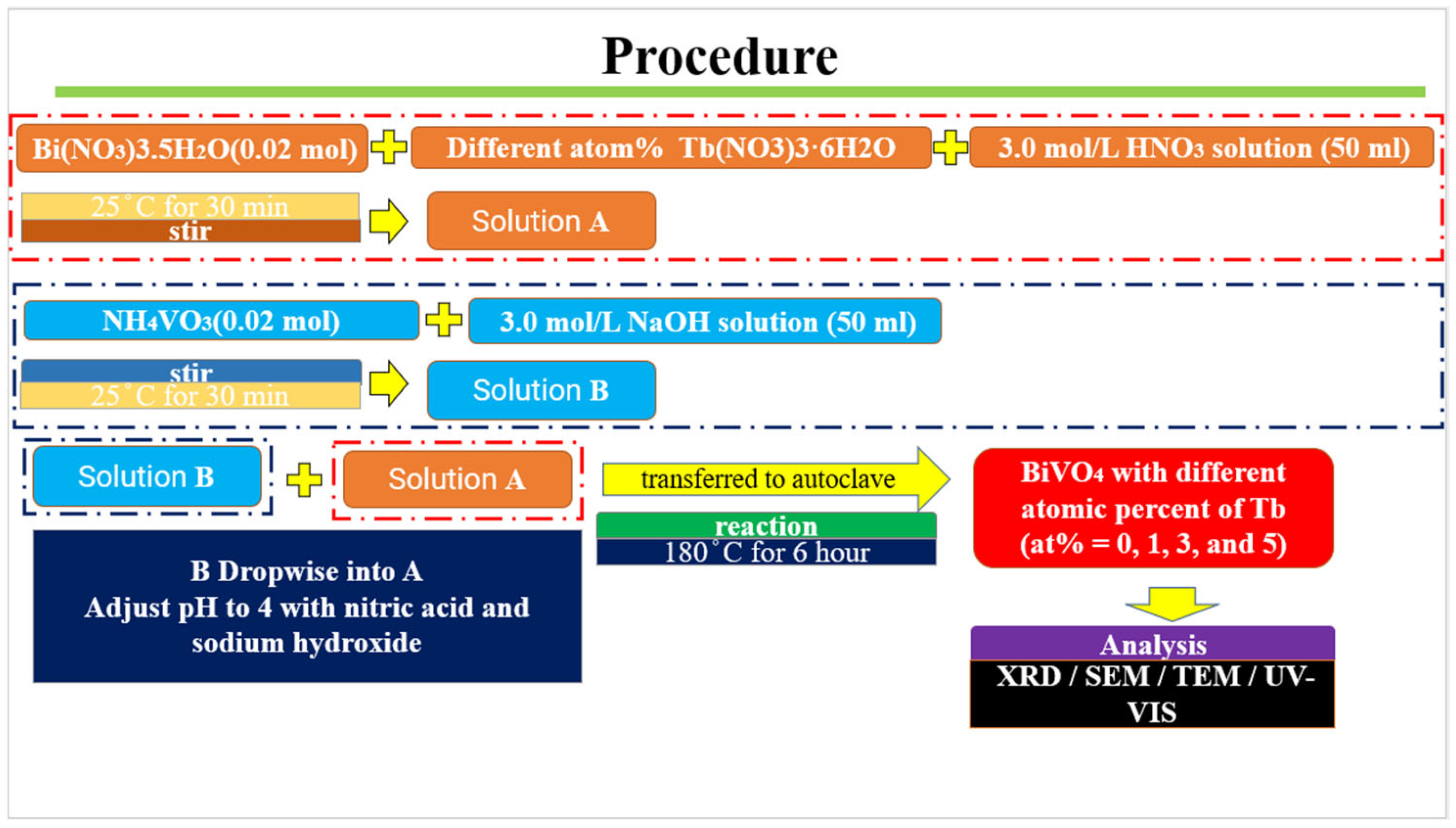






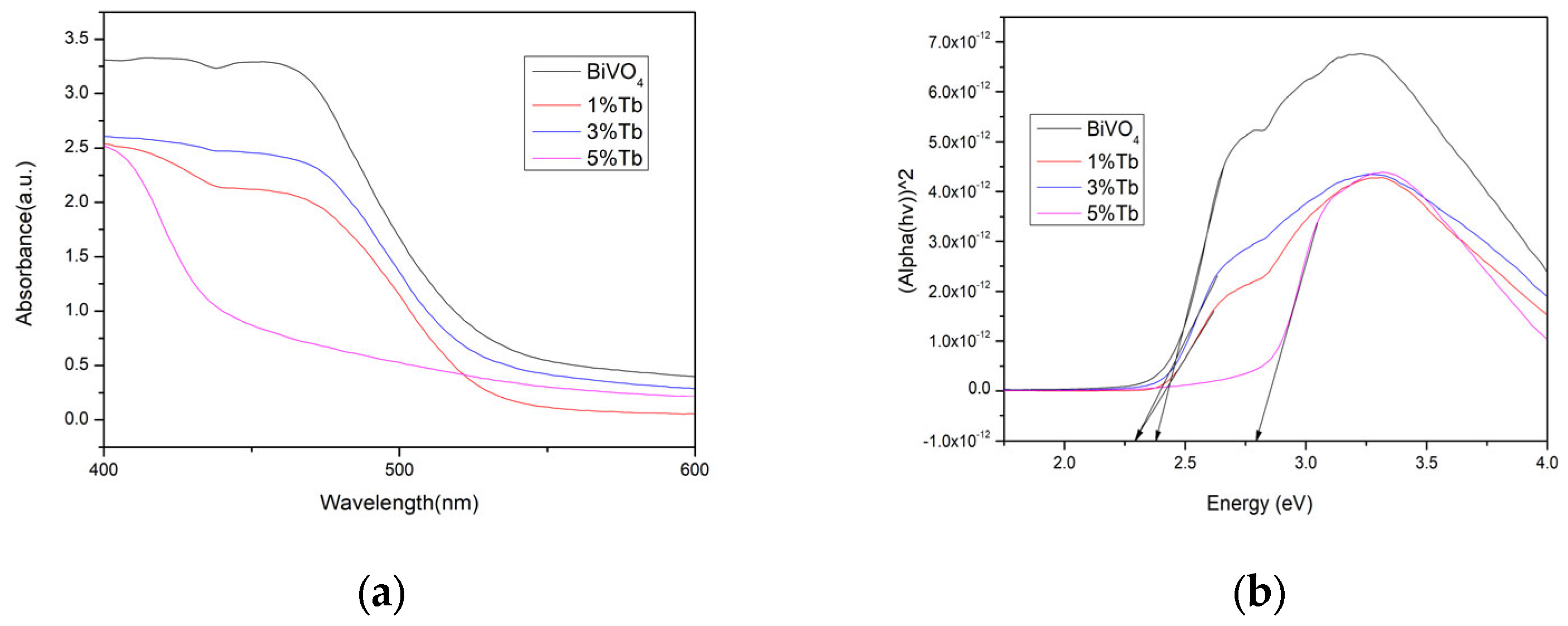




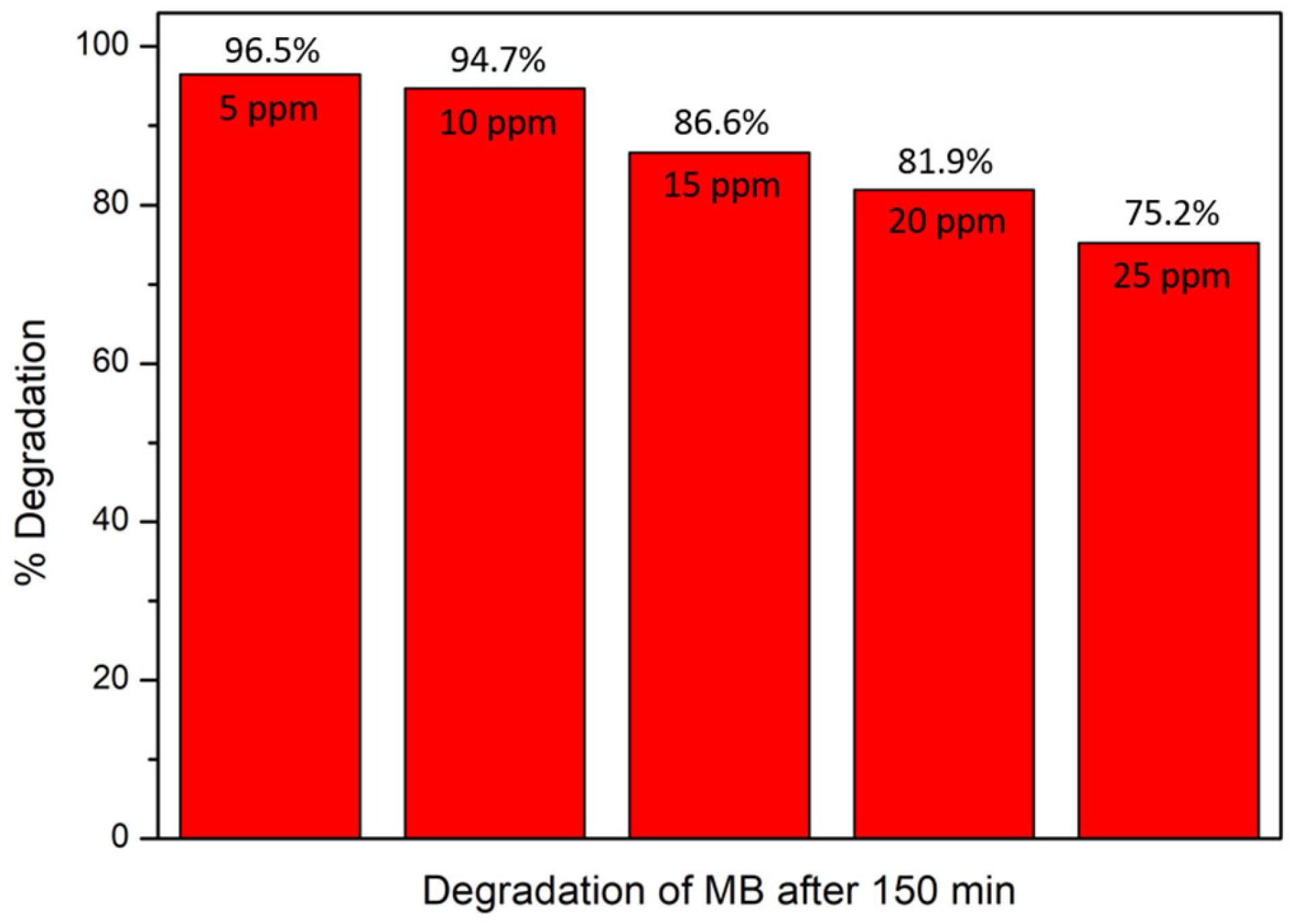
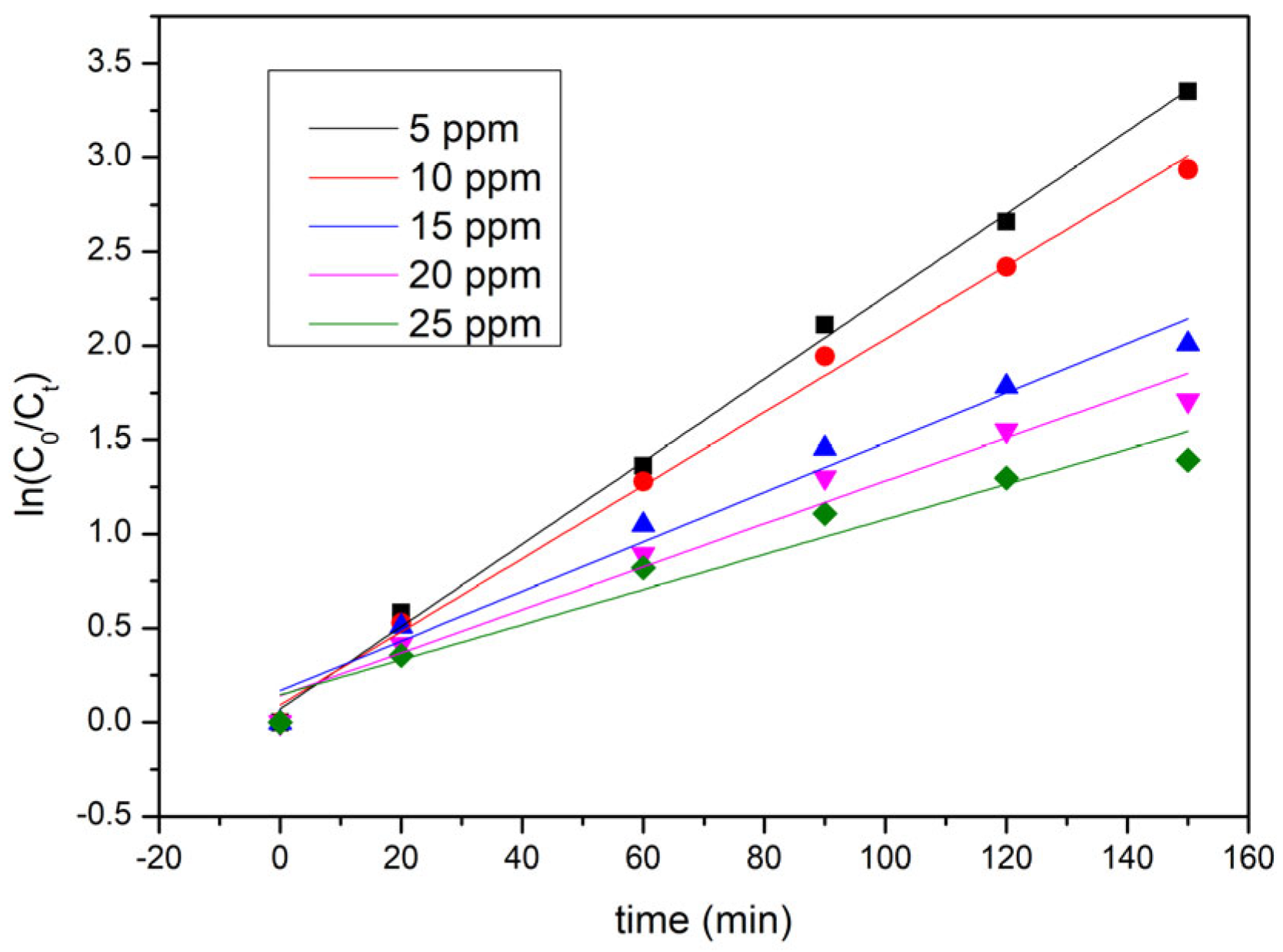

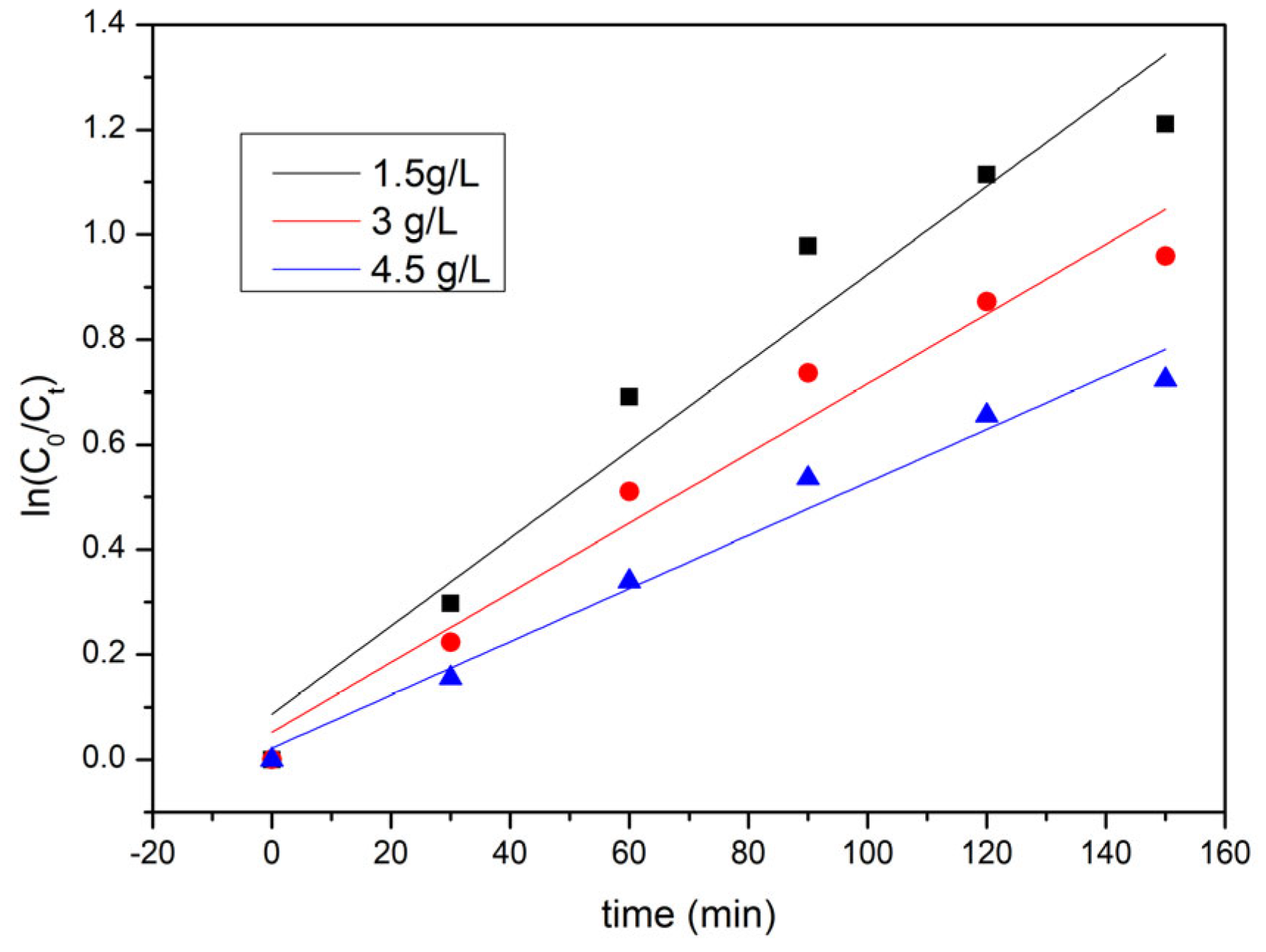

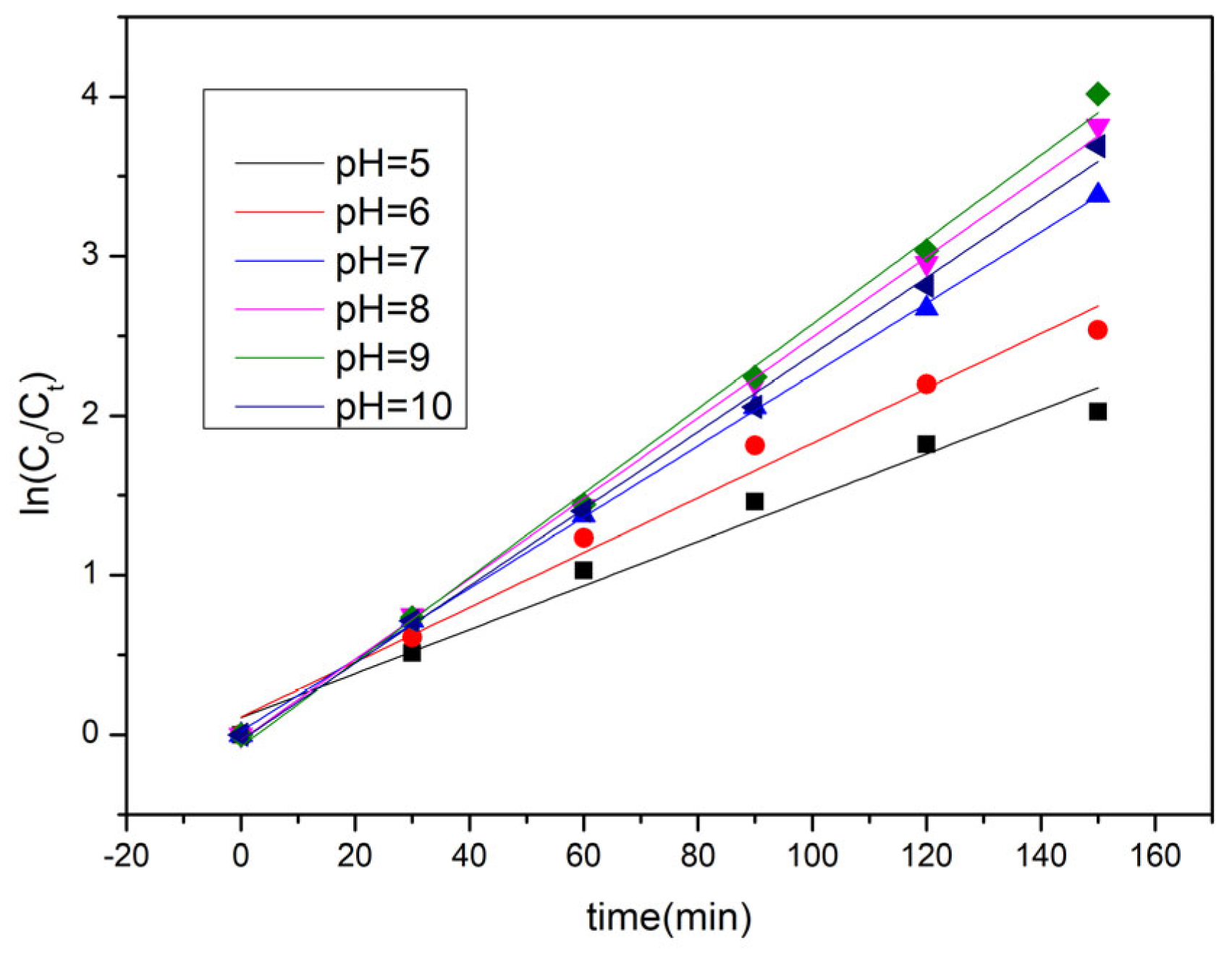
| BET | BiVO4 | 1%Tb | 3%Tb | 5%Tb |
|---|---|---|---|---|
| Surface Area | 4.41 | 5.34 | 5.63 | 5.72 |
| Sample | Bi Peak (4f7/2, 4f5/2) | Tb Peak (4d) | V Peak (3p3/2, 3p1/2) | O Peak (1s) |
|---|---|---|---|---|
| BiVO4 | 164.43, 159.0 | none | 517, 523 | 529.5, 531.3 |
| 3%Tb | 158.78, 164.08 | 156.39 | 516.75, 524.16 | 529.42, 530.51 |
| Sample | BiVO4 | 1%Tb | 3%Tb | 5%Tb |
|---|---|---|---|---|
| Band gap | 2.37 | 2.29 | 2.29 | 2.79 |
Disclaimer/Publisher’s Note: The statements, opinions and data contained in all publications are solely those of the individual author(s) and contributor(s) and not of MDPI and/or the editor(s). MDPI and/or the editor(s) disclaim responsibility for any injury to people or property resulting from any ideas, methods, instructions or products referred to in the content. |
© 2023 by the authors. Licensee MDPI, Basel, Switzerland. This article is an open access article distributed under the terms and conditions of the Creative Commons Attribution (CC BY) license (https://creativecommons.org/licenses/by/4.0/).
Share and Cite
Chen, W.-S.; Wu, M.-H.; Wu, J.-Y. Effects of Tb-Doped BiVO4 on Degradation of Methylene Blue. Sustainability 2023, 15, 6994. https://doi.org/10.3390/su15086994
Chen W-S, Wu M-H, Wu J-Y. Effects of Tb-Doped BiVO4 on Degradation of Methylene Blue. Sustainability. 2023; 15(8):6994. https://doi.org/10.3390/su15086994
Chicago/Turabian StyleChen, Wei-Sheng, Ming-Hong Wu, and Jun-Yi Wu. 2023. "Effects of Tb-Doped BiVO4 on Degradation of Methylene Blue" Sustainability 15, no. 8: 6994. https://doi.org/10.3390/su15086994
APA StyleChen, W.-S., Wu, M.-H., & Wu, J.-Y. (2023). Effects of Tb-Doped BiVO4 on Degradation of Methylene Blue. Sustainability, 15(8), 6994. https://doi.org/10.3390/su15086994







